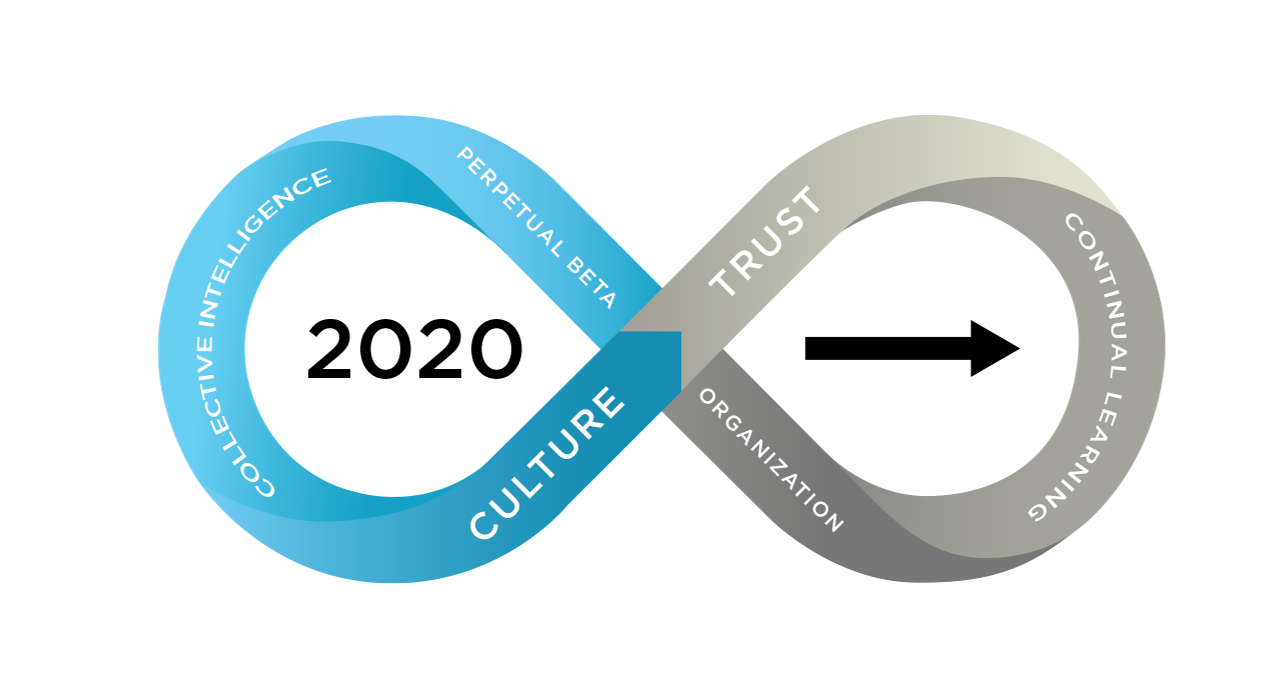Iterate and test, repeat: All innovative software companies practice this product development cycle constantly. These companies assume that continuous iteration for continuous improvement delivers superior customer experience and value. What two ideas underpin this practice of perpetual beta? First, the notion that collective intelligence results in excellence; second, the conviction that users are part of the ongoing development process. Customer-centricity drives the perpetual beta.
The CEO in 2020 has been foisted into a hyper perpetual beta mode for operating the entire company. I think you are well-served to talk to your teams about your current beta program and consider deliberately practicing this approach for all aspects of your “organizational product.”
The perpetual beta process has profound, positive outcomes:
1. You are forced to focus on what is working versus what you wish was working. You start to accept the world as it is versus what you wish it would be.
2. You develop a keen ear and understanding of the second-order drivers of customer desires and satisfaction. You become tuned to the small cues.
3. You distinguish between relevant and irrelevant information from the marketplace, analysts, customers and even employees.
4. You extend yourself and the company to break through to a step function improvement proven to be attained versus impossible.
The fundamental reason why perpetual beta is so effective is deliberate practice. It defines and concentrates effort for a singular result. Successive singular results build on one another, transitioning from tactical decisions to strategic implications. These assist in shaping a mental model of where you want to go across time horizons. Perpetual beta will reduce variance and improve forecasting. Ultimately it will instill confidence leading to conviction to make a bigger bet on your business in 2021.
Most companies made impressive adjustments between March and April. You have a monthly financial report and quarterly assessment cadence. Building a repetitive test, learn, collective intelligence virtuous circle for employee trust, go-to-market operations and capital allocation decisions will underpin those quarterly targets and, more importantly, create a stronger 2021 company. I will expand on just two examples:
1. Employee Trust Platform:
There is probably no greater perpetual beta program underway than those concerning employee work location and travel. The WFH-mix, combined with the decision on the timing and phasing of of employees returning to the office, is assuredly a testing and development cycle. The multivariate process encompasses office issues, public infrastructure, domestic inputs, and the overarching criticality of company competitiveness for survival, results and success. This situation is ripe for isolating a specific test and measuring “features” in a continuum. There will undoubtedly be new twists and turns over the next three years. A recurring sustainable beta program that Boards and companies implement today will become a natural core competency regarding not just customer and employee welfare but also maximizing company productivity amid constraints.
2. Discovery & Demo Zone:
The dramatic disruption from field to inside sales, marketing and account management is a universal constraint experienced by all of you and the rest of the business world. It is not how we wish it to be, but we should assume it is the unwanted norm (exceptions will happen) for the rest of 2020, at least. Selling necessitates a much larger weighting on science than art in this video-saturated era. It requires a step-function change in discovery and demo excellence.
The beta program for isolating subset elements of the GTM playbook could include two streams:
a. Intense breakdown of discovery questions and a re-written script for second-level cues over a series of 50 – 100 first-time sales meeting appointments. Nuances can close a contested deal.
b. Intense breakdown of your demo in one-minute increments (20 increments) to test and determine how to get to “the greatest 20-minute product demo I have ever seen.” Beta could be done with 50 plus demos in an actuarial manner. This process improvement requires product management leadership, sales leadership and R&D leadership to attend breakdown sessions together. Yes, these can be recorded with permission and the internal breakdown sessions can be scheduled with five to seven demos at a time in one session for efficient, dedicated time allocation.
Use a beta program not just for product features but for the complete sales cycle.
Your market, customers, subscribers and employees are all in the same situation at the same time. They are all co-developers and collectively providing you signals and feedback daily. This is not “normal.” It is extraordinary. It has not happened like this ever before. CEOs and teams who develop a company-wide perpetual beta mindset and model are the ones to win long term.

